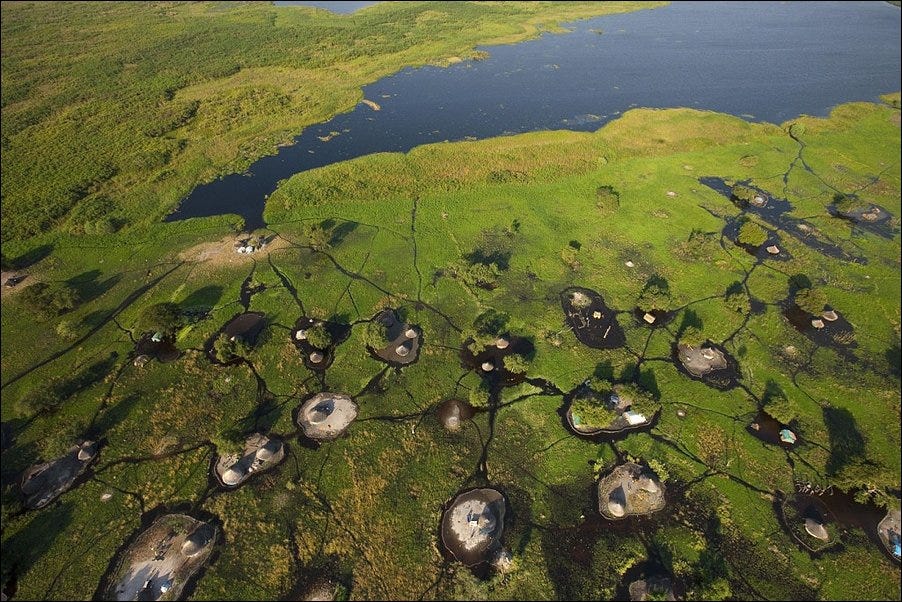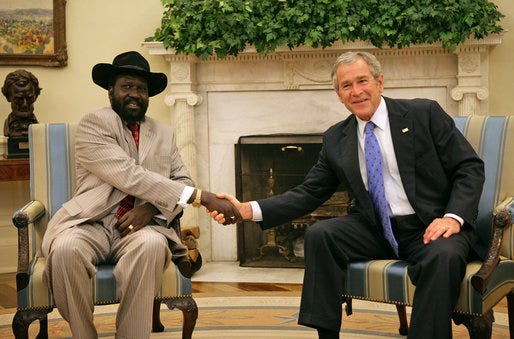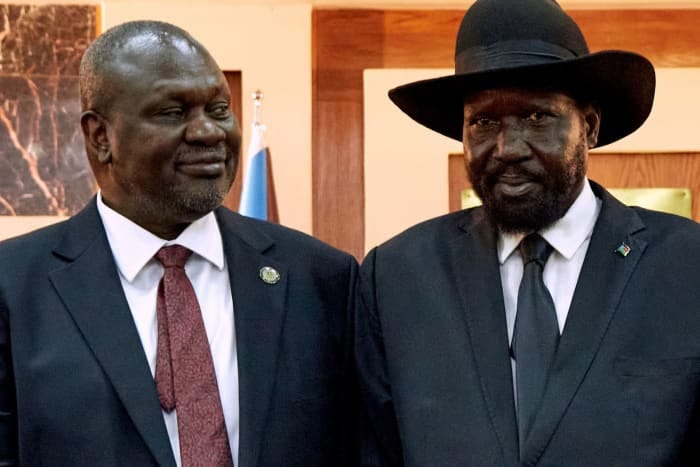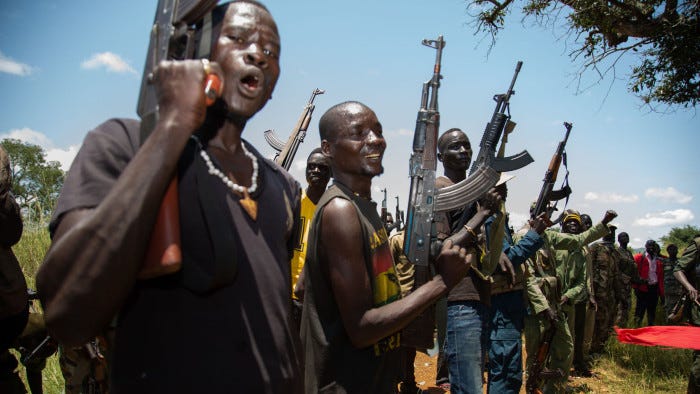The Economic & Geopolitical history of South Sudan
How dozens of African tribes resisted Turkish, Egyptian, British & Sudanese Arab Rule
Yo! If you've read the article on Sudan, much of this will cover similar ground but with added insights from the South Sudanese perspective in one article. The new info here will be the South Sudanese Civil War and the aftermath. If you haven’t read my articles on North Sudan, check out parts 1, 2, 3, and 4.

As of 2024, South Sudan is a 13-year-old landlocked nation, roughly the size of the UK, Iceland, Portugal, the Netherlands, Belgium, Ireland, Luxembourg, and Switzerland combined. It is home to approximately 12 million people, is the 2nd least developed nation on earth, and is tied for 2nd most corrupt state. Life expectancy is 56 years old as of 2022.

The country is in Northeast Africa, and the capital is Juba. The country is home to over 60 ethnic groups, including the Dinka (also known as “Jieng”), Nuer (“Naadh”), and Shilluk(“Collo”). Most of the population practices Christianity or traditional African religions.
As one of the poorest nations in the world, South Sudan's economy is primarily agricultural, with ~80% of the population working as farmers. However, it struggles with some of the lowest crop yields globally. South Sudan’s agriculture is subsistence-based, with limited data available for crops like wheat or potatoes, though rice and maize yield figures are accessible. They are abysmal.
In 2011, South Sudan seceded from the North, taking 75% of the country's oil reserves—about 3.8 billion barrels, ranking 26th globally, more than Egypt but less than Oman or Mexico. Nearly 90% of South Sudan's exports are crude oil, primarily sent to China. Oil is the backbone of its economy, accounting for ~90% of government revenue and foreign currency. Despite this, in 2022, the country exported less than half a billion dollars' worth of crude oil, highlighting its economic vulnerability. The state owned oil firm NilePet, has been used as a slush fund to pay South Sudanese politicians, military officials, and family members, fueling a patronage system.
South Sudan has a consortium joint venture called Dar Petroleum Operating Company, with state owned firm Nilepet owning 19%, China’s Sinopec owning 41% and Malaysia’s Petrobas owning 40%. The firm was made when South Sudan was part of Sudan. Petrobas and South Sudan are currently in a legal dispute.
South Sudan's rugged terrain and low-lying plains leave large parts of the nation prone to severe flooding, displacing around one million people annually. Despite its oil reserves, the economy has shrunk since independence. Below you will see a graph that demonstrates that inflation adjusted incomes in South Sudan has worsened since independence.

Pre-Colonial History
Before South Sudan existed as a state, the region was home to hundreds of decentralized African tribes, chieftains, and villages, especially from the Nuer and Dinka. The first tribe to centralize power was the Shilluk Kingdom in the 1700s, situated just south of Sennar (modern-day Sudan). The Shilluk had been established since the 1490s and controlled the White Nile. Sometimes these tribes traded & fished together, other times they fought and raided on other tribes’ cattle.
Meanwhile, the region now called Sudan, which was Sennar & Darfur, underwent centuries of Arabization/Islamization as Arabs from Arabia & Egypt migrated and intermingled with the Africans. However, South Sudan resisted this due to its swampland, The Sudd, which acted as a natural barrier.
Due to the Sudd swamp, South Sudan shares more cultural ties with Sub-Saharan Africa, while North Sudan is closer to Egypt culturally. South Sudanese tribes like Nuer also live in Ethiopia, Azande also live in Congo & Central African Republic, and Luo also live in Uganda & Kenya. In the South, many were animists, with some tribes having a "Rain Chief" who received gifts & taxes for “making it rain”. But if drought occurred, the chief could be killed or looted, as seen when Nyigilo, a "Rain Maker," was hunted down and killed for failing to bring rain.
Turko-Egyptian Colonialism (1821-1898)
“You are aware that the end of all our efforts and this expense is to procure negros. Please show zeal in carrying out our wishes in this capital matter.” —Mohammed Ali Pasha, ruler of Turkish Egypt
Before European colonization, Mohammed Ali Pasha, the Albanian Turkish ruler of Egypt, launched his own African conquest. By the 1800s, he controlled Egypt and expanded his empire to parts of modern day Sudan, slivers of Ethiopia, Eritrea, Djibouti, Sudan, South Sudan, parts of Central African Republic, slivers of East Chad, parts of Somalia, and Northern Uganda.

South Sudan was incorporated into Sudan during Mohammed Ali Pasha’s conquest of Africa in search of slaves and gold, which back then were three provinces called Bahr Al Ghazal, Equatoria, and Upper Nile.
South Sudan, especially Upper Nile, became a key slave source for Arab Sudanese and Egyptians. Though the Shilluk tribe resisted, Egyptian technology overpowered them. Along with slaves, Egyptians extracted ivory, cattle, and grain from the region, depleting the ivory by 1857. Arab Sudanese slave traders manipulated local tribes, capturing around 2,000 slaves annually.
After Britain took the Suez from Egypt in 1875, two years later in 1877, Britain pressured Egypt to end slavery through the “Convention for the Suppression of the Slave Trade”. Unfortunately, it persisted, as the idea of enslaving non-Muslim Africans was deeply ingrained in Sudanese society. The Northern Sudanese Arabs called the Southerners “Abid” (Slave).
Meanwhile, European Catholic missionaries began spreading Christianity in South Sudan, Their impact was minimal as many died from deadly diseases like malaria and yellow fever. They built churches and documented local languages like Dinka.
By 1880s, the Sudanese Mahdiyya zealots briefly gained independence from Turkish Egypt, slave raids in the South intensified alongside forced Islamic conversions.
While Mahdist Sudan enslaved the south, European powers stepped in the fray. King Leopold II of Belgium aimed to incorporate South Sudan into his Congo Free State, nearly capturing Western Equatoria. France also sought to that land, making treaties with Shilluk kings and occupied Upper Nile. Britain, though uninterested in Sudan (PM Salisbury called Sudan “large tracks of useless territory”), found itself entangled due to its control of Egypt (which Egypt wanted Sudan back) and the Suez Canal. By 1898, Britain and Egypt had defeated the Mahdists and established the British-Egyptian condominium, kicking out Belgium & France from the area.
British-Egyptian Colonialism (1899-1955)
“The South is totally different from the North.” — noted a British Administrator. When Britain took over, it abolished slavery but had to spend 30 years quelling Northern Sudanese slave raids into the South, stamping out the slave trade by 1929.
While Britain invested in Northern Sudan, building projects like the Sennar Dam and Kitchener School of Medicine, it neglected the South, where few customs changed, and some tribes remained isolated.
Also, in 1930, Britain enforced a policy of separation between North and South to block the spread of Islam and Arab culture, the British made a Southern army called the Equatoria Corps. Missionaries from US, Australia, and Britain proselytized in the South, converting some of the Animists into Christianity.
British rule relied on indirect governance through tribal chiefs, which altered traditional power structures and deepened tribalism. Originally, chiefs were spiritual leaders, but Britain transformed them into political rulers. It’s like turning Reverend Martin Luther King into a Mayor.
In the 1940s, Britain considered integrating South Sudan with either the North, the East African Federation(Kenya, Uganda, Tanganyika), or splitting the South between Uganda and Kenya. However, Northern Sudanese and Egyptians favored a unified Sudan under Egyptian domain, called “Unity of the Nile Valley”. The South originally wanted independence or unite with British Uganda or Belgian Congo. The South were scared of joining the North since the Sudanese Arabs historically enslaved them, but the North said they had no desire to dominate them.
But in 1947, at the Juba Conference, Southern leaders reluctantly agreed to unification, coerced by Northern delegates through threats/bribes and promises of autonomy.
In reality, the northern elite did not think the South were capable of running their own affairs and thought the South was “mentally colonized” for adopting Christianity. The North thought that if the South had autonomy, then the Africans would just kill each other over their tribal identities. Thus, the Northern political elite believed it was imperative to Islamize/Arabize the south so that they would renounce their African tribal identities.
Britain, realizing it had set the South up for Northern domination, rushed to develop the region with the short time Britain had remaining — building schools and launching cotton cultivation projects.
By 1953, Sudan acquired self-governance from the British. Sudan crushed the provision of Southern autonomy and rolled back the idea of uniting with Egypt. The few politically conscious southerners were angry and amassed a political party called the “Southern Liberal Party” to advocate for autonomy. .
When the British civil service was being replaced, Northerners took 99% of the positions, excluding the South. The South was also maltreated, which caused the Southerners to riot, attack, and kill 250+ Arabs that were working in the South. A year before Sudan became independent, the South’s Equatoria corps mutinied at Torit and started the first South Sudanese rebellion.
North Arab Sudanese Domination (1956-2011)
Southern Rebellion #1:
When Sudan gained independence in 1956, the North began a policy of Arabization/Islamization, expelling Christian missionaries and killing the resisting Southerners and burning their homes, forcing many elite Southerners to flee to neighboring countries. The South had two strategies: the vanguard peace & militant initiatives.
The Vanguard Peace Initiative: Southern intellectual refugees formed groups like the Sudan Christian Association in Uganda & the Sudan African National Union in Congo. They tried appealing to the United Nations but were ignored. They also tried a round table conference with the North Sudanese and had the Organization of African Unity as a mediator, but it failed since no one wanted to make concessions.
The Vanguard Militant Approach: The Southerners that remained in the country formed the militant group, Anya Nya (Snake Venom) 1963, initially armed with arrows & spears. Israel provided the South real weapons to them, which allowing them to launch a sustained campaign.
Why did Israel help the South? In the 1950s-1970s, Israel had a foreign policy called the "Periphery Doctrine" which aimed to create alliances with non-Arab/non-Muslim groups or marginalized minorities in the region. To combat the hostility Israel faced from its Arab neighbors, Israel supported the Maronites in Lebanon, the Kurds in Iraq, the Druze in Syria, and the Southerners in Sudan.
With both initiatives failing, the war brutalized with massacres occurring in Juba, Torit, Yei, Maridi, and Wau, where the North shot up a wedding in the South. By 1971, a new rebel group emerged called the Southern Sudan Liberation Movement, where Anya Nya rebels and South Sudanese exiles united.
In 1972, Sudan signed a peace deal with the South, and the three provinces (Upper Nile, Bahr Al-Ghazal, and Equatoria) were combined, creating an autonomous government. The war was over with 1.3M people dead and several 100K more were refugees in neighboring countries.
Honeymoon Period #1:
Autonomy wasn’t great, the south still had food shortages, and the North ignored the South’s water rights. The Anya Nya was integrated in the Sudanese army, but there were mutinies. Also, within the south, the government became a corrupt Dinka Supremacist state, where Dinka-ethnics had over half representation in the national assembly.
After oil was discovered in South Sudan, the North instated Islamic law in the Christian/Animist South, revoked their autonomy, and split the South into its original three provinces in 1982-1983.
Southern rebellion #2:
Unable to accept the oppression, the Dinka rebel, John Garang, created the Sudan Peoples’ Liberation Army/Movement (SPLM/A) in 1983. He received support from Gaddafi of Libya, Museveni of Uganda, and Miriam of Marxist Ethiopia.
Southern Rebellion #2:
After coups, elections, and more coups, in 1989, Omar Al-Bashir ruled Sudan and doubled down on controlling the South. Egypt, Nigeria, and Kenya tried to broker peace in the early 90s, and they all failed. There were accounts of Southerners being sold into slavery for $50 per human.
Omar Al-Bashir utilized a “divide-and-rule” strategy against the SPLM, taking advantage of their existing divisions. For example, Garang wanted a united secular, democratic Sudan while other groups wanted secession. Some rebels, like Riek Machar, a Nuer, made splinter groups from the SPLM.
Al-Bashir signed a peace deal with 6 Southern rebel groups that hated the Dinka dominated SPLM. Due to this, more South Sudanese died due to local infighting rather than the hands of the Northern Arabs. For example, the Bor Massacre in 1991 was Nuer vs. Dinka. While the Southerners kill each other, Al-Bashir was able complete his oil pipeline and extract crude from from South Sudan in 1999.
America’s sanctions were taking its toll on Al-Bashir and he slowly relented. Al-Bashir signed the Machakos Protocol with the SPLM in 2002, and in 2004, Al-Bashir signed the power sharing agreement as well.
After 2.5M deaths, thanks to the UN and United States under the Bush administration, the comprehensive peace agreement (CPA) was signed in 2005. President Omar Al-Bashir was President of Sudan, Dr. Garang would be Vice President. Sudan and South Sudan would share oil revenues, South Sudan was given autonomy, and South Sudan was granted a referendum on independence.
Honeymoon #2:
Tragically, Garang died in a plane crash shortly after the CPA, and Salva Kiir took over leadership.
In April 2010, a year before independence, Kiir was elected as president of South Sudan with 93% of the vote. The following year in July 2011, 99% voted to leave Sudan and a new sovereign state was formed.
Independence & Salva Kiir (2011-Present)
In a gesture of unity, South Sudan's President Salva Kiir appointed his former enemy, Riek Machar, a Nuer, as Vice President. Machar had led a Nuer-dominated SPLA splinter group during the second rebellion and was responsible for the Bor Massacre, where many of Kiir’s Dinka tribe were murdered. By making Machar his deputy, Kiir sought reconciliation. Machar later publicly apologized for his role in the massacre, symbolizing an effort to bridge deep ethnic divides. The country then joined the East African federation in 2012.
Unfortunately the country still had issues. South Sudan’s economy was largely informal, and lacked infrastructure and telecommunications.
Tensions with Sudan: After South Sudan’s independence, the oil-rich Abyei region remained disputed, with both countries sending troops to claim it. Other contested areas, such as South Kordofan and Blue Nile, which were incorporated into Sudan, sought to join South Sudan. Salva Kiir backed rebel movements in these regions, while Sudan’s leader, Omar Al-Bashir, retaliated with airstrikes, displacing 350,000 people who fled to South Sudan.
Also, in 2012, Al-Bashir raised oil transit fees, prompting Kiir to shut down the pipeline, devastating both economies. While a 2012 agreement resumed oil flows by 2013, unresolved issues over Abyei still loom.
Internal Tensions: South Sudan may have been independent, but many tribes disliked each other. In Jonglei, the Nuer and Murle killed each other over cattle in 2011-2012. When Kiir tried to intervene, the Murle formed a militia.
Riek Machar, Kiir’s VP, began to challenge Kiir’s leadership accusing him of incompetence and corruption, creating a rivalry between the two.
South Sudan Civil War (2013-2020)
In 2013, Kiir accused Machar of attempting a coup after fighting broke out, sparking a civil war between the Dinka, loyal to Kiir, and the Nuer, backing Machar. Machar denied the coup and led the SPLM-IO (Sudan People's Liberation Movement in Opposition) against Kiir’s SPLM.
Uganda’s President Museveni sent troops to support Kiir, while Sudan’s President Al-Bashir initially backed Machar. Despite massacres and a famine in 2017, the two rivals formed a unity government in 2020 after numerous broken ceasefires.
The war devastated South Sudan, leaving 400,000 dead, mass rape, and 4 million displaced. Oil infrastructure was heavily damaged, further crippling the economy. South Sudan now had 42% of its people displaced and 75% needing humanitarian aid.
The Aftermath: Oil as Political Glue:
Oil remains South Sudan's lifeblood, tying together Salva Kiir & the country’s elites through a violent patronage network instead of benefitting the people. Imagine this, there are violent rebel groups who threaten you or your constituency with mayhem unless you pay off that faction.
However, the country's pipelines are compromised due to Sudan’s civil war, pushing South Sudan to explore export routes through Kenya and Ethiopia. Also, environmental damage caused by oil leaks from foreign firms like Malaysia’s Petronas and China’s Sinopec has exacerbated the public health crisis (kids are born with deformities). With civil servants unpaid since October 2023 and the South Sudanese pound in freefall, Kiir's grip on power depends on securing oil revenues and aid.
International Support & Elections
South Sudan relies on foreign aid, especially the $1B dollars from the U.S as its biggest donor. The country also took its first IMF emergency loan ($115M) in 2023 and its borrowing $12B from the UAE for infrastructure.
South Sudan will delay its first election until 2026. Why has it been so long? President Salva Kiir has made a habit of postponing elections since South Sudan was an autonomous unit in Sudan. This habit has enabled him to remain the de facto president since 2005, before South Sudan’s independence in 2011. He has extended his term in 2015, 2018, 2020, and 2022. If these elections aren’t managed carefully, there’s potential for greater violence in South Sudan.
Final Thoughts
The South Sudanese have been dominated by the Turks, Egyptians, British, and the North Sudanese. Now that they are independent, they established a kleptocratic landlocked, patronage petrostate that doesn’t export much oil. Even South Sudan’s oil minister says alarming speeches like “I don’t see the money. I only see figures on paper.”
The country is deeply divided, with Kiir’s Dinka’s dominating 60% of the government cabinet despite being 35% of the population. If the country can get out of its own way, it can do great. There’s no reason to live in subsistence farming when they have abundant arable land near the Nile.
















Very interesting article. I had no idea about the Sudd wetland and its importance to the history of the area.
Very excited about the article on Uganda! The country has consistently been punching above its weight, and I am surprised that it is richer than Rwanda on a per-capita basis across most metrics, would like to hear how they pulled it off